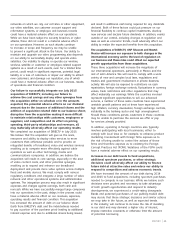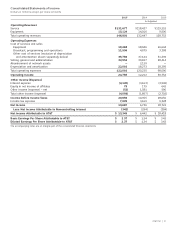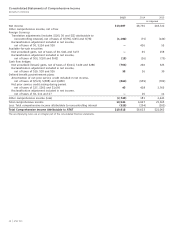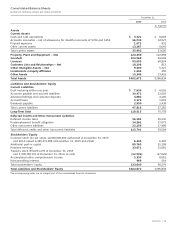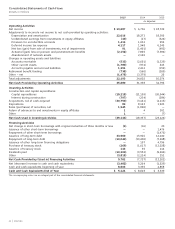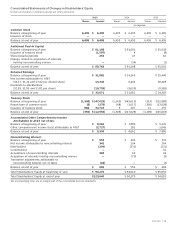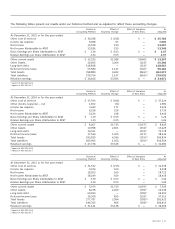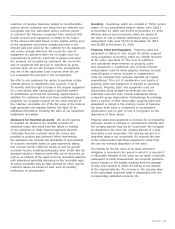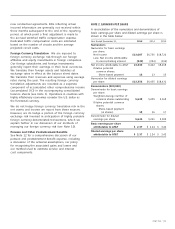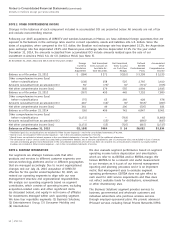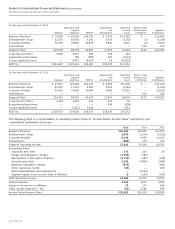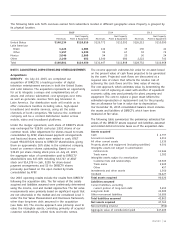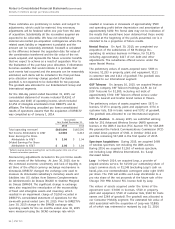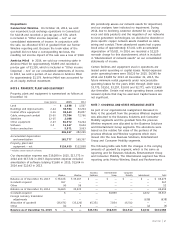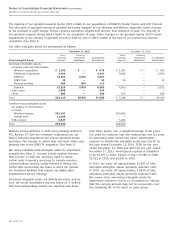AT&T Wireless 2015 Annual Report Download - page 51
Download and view the complete annual report
Please find page 51 of the 2015 AT&T Wireless annual report below. You can navigate through the pages in the report by either clicking on the pages listed below, or by using the keyword search tool below to find specific information within the annual report.
AT&T INC.
|
49
Inventory Inventories, which are included in “Other current
assets” on our consolidated balance sheets, were $4,033
at December 31, 2015, and $1,933 at December 31, 2014.
Wireless devices and accessories, which are valued at
the lower of cost or market (determined using current
replacement cost), were $3,733 at December 31, 2015,
and $1,858 at December 31, 2014.
Property, Plant and Equipment Property, plant and
equipment is stated at cost, except for assets acquired
using acquisition accounting, which are initially recorded
at fair value (see Note 6). The cost of additions
and substantial improvements to property, plant
and equipment is capitalized, and includes internal
compensation costs for these projects; however, noncash
actuarial gains or losses included in compensation
costs are excluded from amounts reported as “capital
expenditures.” The cost of maintenance and repairs of
property, plant and equipment is charged to operating
expenses. Property, plant and equipment costs are
depreciated using straight-line methods over their
estimated economic lives. Certain subsidiaries follow
composite group depreciation methodology. Accordingly,
when a portion of their depreciable property, plant and
equipment is retired in the ordinary course of business,
the gross book value is reclassified to accumulated
depreciation, and no gain or loss is recognized on the
disposition of these assets.
Property, plant and equipment is reviewed for recoverability
whenever events or changes in circumstances indicate that
the carrying amount may not be recoverable. We recognize
an impairment loss when the carrying amount of a long-
lived asset is not recoverable. The carrying amount of a
long-lived asset is not recoverable if it exceeds the sum
of the undiscounted cash flows expected to result from
the use and eventual disposition of the asset.
The liability for the fair value of an asset retirement
obligation is recorded in the period in which it is incurred if
a reasonable estimate of fair value can be made. In periods
subsequent to initial measurement, we recognize period-to-
period changes in the liability resulting from the passage
of time and revisions to either the timing or the amount
of the original estimate. The increase in the carrying value
of the associated long-lived asset is depreciated over the
corresponding estimated economic life.
reduction of revenue. Revenues related to nonrefundable,
upfront service activation and setup fees are deferred and
recognized over the associated service contract period
or customer life. Revenue recognized from contracts that
bundle services and equipment is limited to the lesser
of the amount allocated based on the relative selling price
of the equipment and service already delivered or the
amount paid and owed by the customer for the equipment
and service already delivered. We record the sale of
equipment to customers when we no longer have any
requirements to perform, when title is passed and when
the products are accepted by customers. We record the
sale of equipment and services to customers as gross
revenue when we are the principal in the arrangement
and net of the associated costs incurred when we are
not considered the principal in the arrangement.
We offer to our customers the option to purchase certain
wireless devices in installments over a period of up to
30 months, with the right to trade in the original equipment
for a new device, after having paid a specified number
of installments, and have the remaining unpaid balance
satisfied. For customers that elect these installment payment
programs, we recognize revenue for the entire amount of
the customer receivable, net of the fair value of the trade-in
right guarantee and imputed interest. See Note 15 for
additional information, including the sales of our equipment
installment receivables.
Allowance for Doubtful Accounts We record expense
to maintain an allowance for doubtful accounts for
estimated losses that result from the failure or inability
of our customers to make required payments deemed
collectable from the customer when the service was
provided or product was delivered. When determining
the allowance, we consider the probability of recoverability
of accounts receivable based on past experience, taking
into account current collection trends as well as general
economic factors, including bankruptcy rates. Credit risks are
assessed based on historical write-offs, net of recoveries, as
well as an analysis of the aged accounts receivable balances
with allowances generally increasing as the receivable ages.
Accounts receivable may be fully reserved for when specific
collection issues are known to exist, such as pending
bankruptcy or catastrophes.


